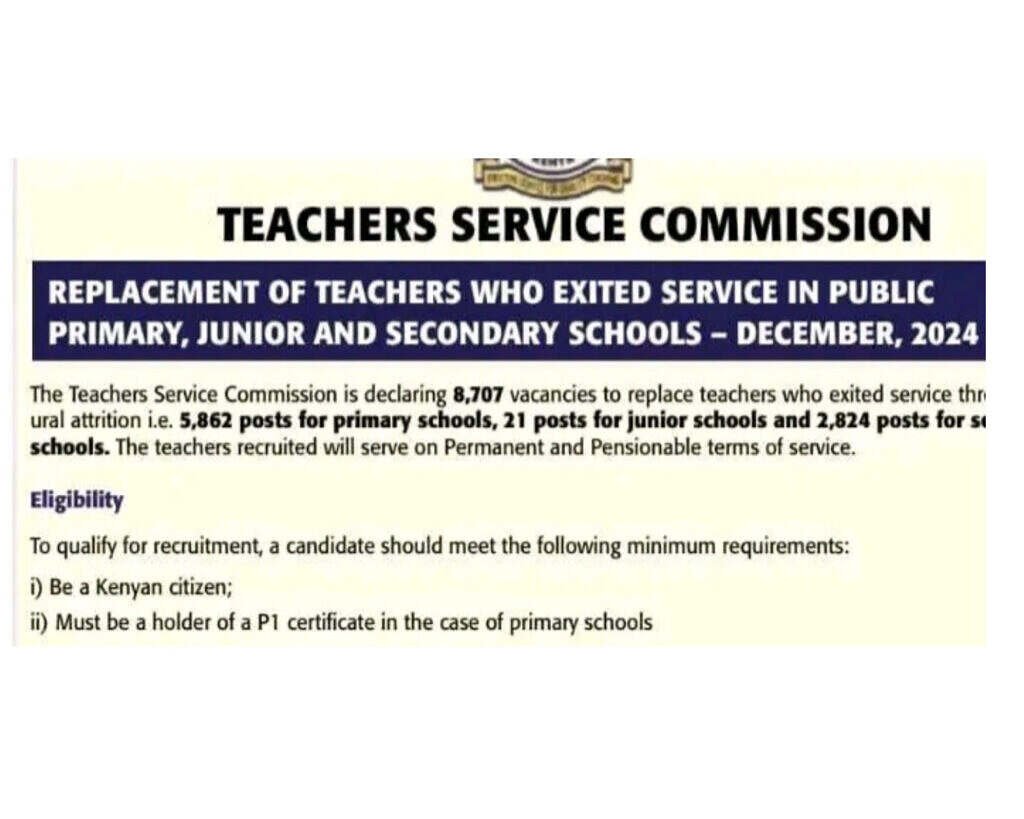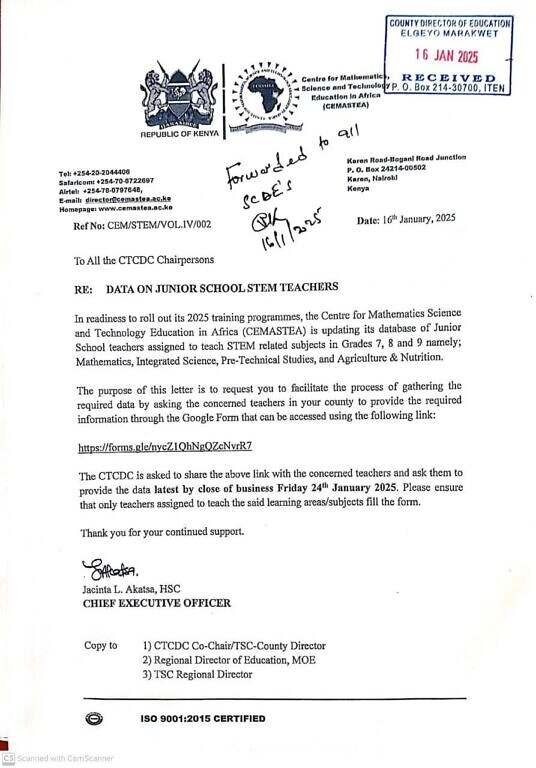
Overview of the TSC Announcement
The Teachers Service Commission (TSC) has recently unveiled a significant announcement regarding the recruitment for a total of 8,707 replacement vacancies among the nation’s teachers. In particular, a noteworthy segment of these positions, comprising 5,862 vacancies, is dedicated specifically for P1 (Primary 1) teachers. This targeted approach highlights the TSC’s commitment to addressing the critical staffing needs within primary education in Kenya, which is essential for fostering a robust learning environment.
The rationale behind these replacement vacancies stems from various factors impacting the education sector. As educators retire or transition into other careers, their vacancies must be promptly filled to ensure continuity and effectiveness in teaching. The predominance of vacant P1 teacher positions underlines the urgent need for qualified professionals capable of delivering quality education to the primary grades. This move not only aims to alleviate the staffing gaps but also addresses the pedagogical requirements of a rapidly evolving educational landscape.
In light of these factors, the TSC’s announcement of 5,862 replacement vacancies is a pivotal step towards ensuring that the educational needs of Kenyan students are met with the utmost efficacy. The impact of this initiative will be closely monitored as the application process unfolds, which is open until January 2025, thereby providing ample opportunity for interested candidates to apply.
Eligibility Criteria for Applicants
The Teachers Service Commission (TSC) has established specific eligibility criteria for individuals seeking to apply for the 5,862 P1 teacher vacancies. Understanding these requirements is crucial for prospective applicants to ensure a successful application process. Firstly, candidates must possess a minimum of a Kenya Certificate of Secondary Education (KCSE) with a mean grade of C (plain) or its equivalent. Furthermore, it is essential that applicants have completed a teacher training program recognized by the TSC, culminating in either a Diploma in Education or a Bachelor’s Degree in Education, accompanied by relevant qualifications in at least two teaching subjects.
Prior teaching experience is another important criterion. Applicants who have previously served as teachers or occupied similar educational roles in registered institutions are strongly encouraged to apply. This experience is vital, as it demonstrates familiarity with the teaching profession, classroom management skills, and an understanding of the curriculum. Additionally, candidates must present evidence of a valid Teaching Practice report, which is pivotal in assessing their practical teaching skills and preparedness for the classroom environment.
Mandatory certifications also form part of the eligibility requirements. All applicants must be registered with the TSC and possess a valid Certificate of Good Conduct from the Kenya National Police Service. This emphasizes the TSC’s commitment to ensuring that only qualified and responsible educators serve in Kenyan schools. Furthermore, while there are no stringent age limits specifically stipulated by the TSC for this recruitment, applicants are expected to embody professional characteristics, such as strong communication skills, creativity, and a dedication to lifelong learning, which are essential for effective teaching.
Application Process and Timeline
The application process for the TSC replacement vacancies for P1 teachers is structured to ensure thorough evaluation and selection of qualified candidates. To initiate your application, you must first gather the necessary documents, which typically include a comprehensive curriculum vitae (CV), certified copies of academic certificates, a valid identification document, and any other relevant certifications that support your application. It is crucial to ensure that all documents are up to date and valid, as this will influence the assessment of your eligibility.
Applications must be submitted through the official TSC online portal, designed to facilitate efficient processing of applications. Candidates are required to create an account on the portal, after which they can fill out the application form and upload the required documents. Additionally, it is recommended that applicants carefully read the guidelines provided on the portal to ensure full compliance with the application requirements. This includes understanding the specific criteria for the P1 positions as well as adhering to the prescribed format for submission.
The timeline for the application process is essential for applicants to keep in mind. The final date to submit applications is set for January 2025, giving candidates ample time to prepare their documents and complete the submission process. Following the application timeline, the TSC will begin the evaluation of submitted applications shortly after this deadline. It is important to stay informed about any updates or additional information released by the TSC regarding the selection process, as key dates for interviews and final selections will be communicated. Maintaining close observance of these timelines will enhance applicants’ chances of securing a position within the TSC.
Implications of the New Vacancies on the Teaching Profession
The announcement of 5,862 replacement vacancies for P1 teachers in Kenya signifies a critical shift in the teaching profession, with profound implications for students, schools, and the education system as a whole. The primary importance of filling these vacancies lies in maintaining a robust educational framework. As experienced educators retire or transition out of the profession, these new positions ensure that classrooms continue to receive the support and expertise necessary for effective teaching. The seamless replacement of outgoing teachers plays a vital role in sustaining educational continuity, which is essential for maximizing student learning outcomes.
Moreover, the influx of new educators can potentially rejuvenate the teaching environment. Fresh perspectives and innovative teaching methods introduced by newly hired teachers may enhance the overall quality of education. This recruitment wave could help to address various gaps in pedagogical practices and encourage collaborations among teachers, ultimately enriching the students’ learning experiences. Furthermore, schools could benefit from the integration of newly qualified teachers who often bring enthusiasm and a commitment to modern teaching techniques, promoting a culture of continuous improvement in schools.
However, several challenges may emerge during the recruitment process. Managing the morale of existing teachers will be critical to ensure a supportive and collaborative workplace. Existing staff may feel threatened by new hires, leading to apprehension about job security or changes in workplace dynamics. It is imperative for school administrations to implement strategies that foster camaraderie and cohesion among all staff members. Additionally, ensuring proper integration of new hires into the school culture and maintaining educational standards during this transition phase will require thoughtful planning and support. Overall, the new vacancies represent both an opportunity and a challenge for the teaching profession, necessitating careful management to enhance educational outcomes across the country.






